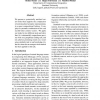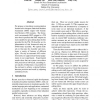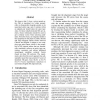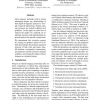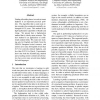ACL
2010
13 years 9 months ago
2010
We present a syntactically enriched vector model that supports the computation of contextualized semantic representations in a quasi compositional fashion. It employs a systematic...
ACL
2010
13 years 9 months ago
2010
Determining the semantic intent of web queries not only involves identifying their semantic class, which is a primary focus of previous works, but also understanding their semanti...
ACL
2010
13 years 9 months ago
2010
We propose a translation recommendation framework to integrate Statistical Machine Translation (SMT) output with Translation Memory (TM) systems. The framework recommends SMT outp...
ACL
2010
13 years 9 months ago
2010
Most sentiment analysis approaches use as baseline a support vector machines (SVM) classifier with binary unigram weights. In this paper, we explore whether more sophisticated fea...
ACL
2010
13 years 9 months ago
2010
We present a novel fully unsupervised algorithm for POS induction from plain text, motivated by the cognitive notion of prototypes. The algorithm first identifies landmark cluster...
ACL
2010
13 years 9 months ago
2010
We observe that (1) how a given named entity (NE) is translated (i.e., either semantically or phonetically) depends greatly on its associated entity type, and (2) entities within ...
ACL
2010
13 years 9 months ago
2010
Combinatory Categorial Grammar (CCG) is generally construed as a fully lexicalized formalism, where all grammars use one and the same universal set of rules, and crosslinguistic v...
ACL
2010
13 years 9 months ago
2010
Once released, treebanks tend to remain unchanged despite any shortcomings in their depth of linguistic analysis or coverage of specific phenomena. Instead, separate resources are...
ACL
2010
13 years 9 months ago
2010
We present a novel framework for automated extraction and approximation of numerical object attributes such as height and weight from the Web. Given an object-attribute pair, we d...
ACL
2010
13 years 9 months ago
2010
Finding allowable places in words to insert hyphens is an important practical problem. The algorithm that is used most often nowadays has remained essentially unchanged for 25 yea...
